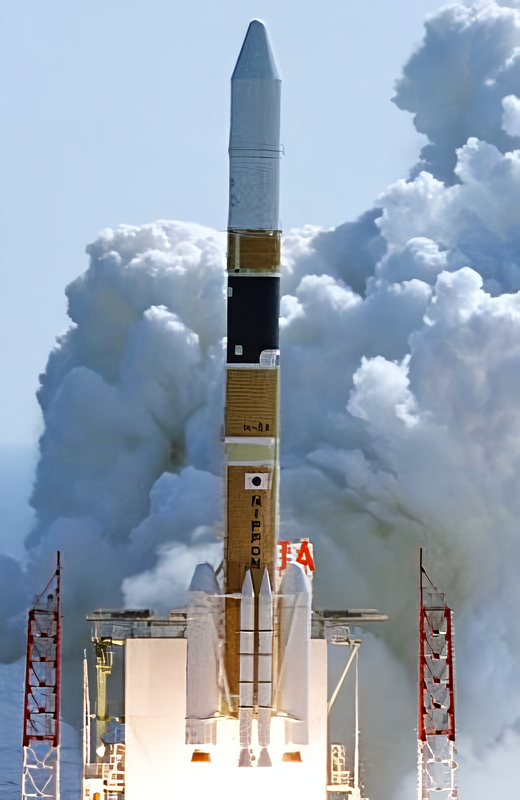
H-IIA
In-activeMitsubishi Heavy Industries (MHI)
Feb. 4, 2002
Description
The H-IIA rocket family is an expendable launch system operated by Mitsubishi Heavy Industries for the Japan Aerospace Exploration Agency. The liquid fuelled rocket has been used to launch satellites, lunar spacecraft and planetary science craft.
Specifications
-
Stages
2 -
Length
53.0 m -
Diameter
4.0 m -
Fairing Diameter
4.0 m -
Launch Mass
347.0 T -
Thrust
―
Family
-
Name
H-IIA -
Family
― -
Variant
2024 -
Alias
― -
Full Name
H-IIA 2024
Payload Capacity
-
Launch Cost
― -
Low Earth Orbit
― -
Geostationary Transfer
Orbit
5000.0 kg -
Direct Geostationary
― -
Sun-Synchronous Capacity
―
Mitsubishi Heavy Industries
Commercial
President: Seiji Izumisawa
MHI 1884Mitsubishi Heavy Industries, Ltd. is a Japanese multinational engineering, electrical equipment and electronics company headquartered in Tokyo, Japan. MHI is one of the core companies of the Mitsubishi Group. MHI's products include aerospace components, air conditioners, aircraft, automotive components, forklift trucks, hydraulic equipment, machine tools, missiles, power generation equipment, printing machines, ships and space launch vehicles. Through its defense-related activities, it is the world's 23rd-largest defense contractor measured by 2011 defense revenues and the largest based in Japan.
H-IIA 2024 | Kizuna
Mitsubishi Heavy Industries | JapanTanegashima Space Center, Japan
Feb. 23, 2008, 8:55 a.m.
Status: Launch Successful
Mission:
WINDS, also called Kizuna, is currently under joint development by JAXA and the National Institute of Information and Communications Technology, as part of the e-Japan Priority Policy Program of the Japanese government's IT strategy headquarters. WINDS was launched by an H-IIA Launch Vehicle in 2008 to establish the world's most advanced information and telecommunications network. It is expected that this information and telecommunications network's speed and capacity will be much higher than anything achieved previously. The WINDS satellite communication system aims for a maximum speed of 155 Mbps (receiving) / 6 Mbps (transmitting) for households with 45-centimeter aperture antennas (the same size as existing Communications Satellite antennas), and ultra-fast 1.2 Gbps transmission for offices with five-meter antennas.
Geostationary Transfer OrbitH-IIA 2024 | IGS Radar 2 & IGS Optical 3V
Mitsubishi Heavy Industries | JapanTanegashima Space Center, Japan
Feb. 24, 2007, 4:41 a.m.
Status: Launch Successful
Mission:
The IGS Radar 2 & Optical 3V (Intelligence Gathering Satellite) are Japanese radar and optical reconnaissance satellites. The satellites are operated by the Cabinet Satellite Information Center. The satellites serve both Japan's national defense and civil natural disaster monitoring.
Sun-Synchronous OrbitH-IIA 2024 | Himawari-7 (MTSAT-2)
Mitsubishi Heavy Industries | JapanTanegashima Space Center, Japan
Feb. 18, 2006, 6:27 a.m.
Status: Launch Successful
Mission:
The MTSAT-2 (Multifunctional Transport Satellite) is a multi-functional satellite with a dual purpose. On the one hand, it is an integral part of a next-generation global-scale air traffic safety system comprised of communications, navigation, tracking and air traffic control. The purpose is to improve traffic congestion and safety in the Asia Pacific region. On the other hand, the MTSAT-2 is designed to take on a meteorological mission to capture, collect and deliver meteorological images and/or data. In this capacity it inherits and expands the mission of a previous satellite.
Geostationary Transfer OrbitH-IIA 2024 | IGS Radar (2) & IGS Optical (2)
Mitsubishi Heavy Industries | JapanTanegashima Space Center, Japan
Nov. 29, 2003, 4:33 a.m.
H-IIA 2024 | IGS Radar 1 & IGS Optical 1
Mitsubishi Heavy Industries | JapanTanegashima Space Center, Japan
March 28, 2003, 1:27 a.m.
Status: Launch Successful
Mission:
The IGS Radar 1 & Optical 1 (Intelligence Gathering Satellite) are Japanese radar and optical reconnaissance satellites. The satellites are operated by the Cabinet Satellite Information Center. The satellites serve both Japan's national defense and civil natural disaster monitoring.
Sun-Synchronous OrbitH-IIA 2024 | USERS & DRTS
Mitsubishi Heavy Industries | JapanTanegashima Space Center, Japan
Sept. 10, 2002, 8:20 a.m.
Status: Launch Successful
Mission:
USERS (Unmanned Space Experiment Recovery System) was a Japanese microgravity experimental satellite. After 8.5 months in orbit, a reentry vehicle was to be returned to earth with the materials manufacturered in space. DRTS (Data Relay & Tracking Satellite) is an inter-satellite communications experiment satellite to relay data between the target spacecraft (low earth orbit satellites, space stations, etc.) and ground stations.
Geostationary Transfer OrbitH-IIA 2024 | Tsubasa
Mitsubishi Heavy Industries | JapanTanegashima Space Center, Japan
Feb. 4, 2002, 2:45 a.m.
Status: Launch Successful
Mission:
MDS 1 (Mission Demonstration Satellite 1), renamed Tsubasa after launch, is a Japanese satellite that was launched by a H-2A-2024 rocket from Tanegashima Space Center at 02:32 UT on 4 February 2002. It was renamed Tsubasa (meaning Wings) after the successful launch.
Elliptical OrbitAriane 62
Galileo L14 (FOC FM33 & FM34)
Ariane Launch Area 4 - Guiana Space Centre, French GuianaPayload consists of two satellites for Europe's Galileo navigation system.
Atlas V 551
Amazon Leo (LA-04)
Space Launch Complex 41 - Cape Canaveral SFS, FL, USAAmazon Leo, formerly known as Project Kuiper, is a mega constellation of satellites in Low Earth Orbit that will offer broadband internet access, thi…
Long March 4B
Ziyuan-3-04
Launch Complex 9 - Taiyuan Satellite Launch Center, People's Republic of ChinaThe ZY-3 (Ziyuan-3, 'Resource-3') series represents China's first high-resolution, stereoscopic mapping satellites for civilian use. The second sa…
Falcon 9
Starlink Group 6-82
Space Launch Complex 40 - Cape Canaveral SFS, FL, USAA batch of 29 satellites for the Starlink mega-constellation - SpaceX's project for space-based Internet communication system.
Falcon 9
Starlink Group 15-12
Space Launch Complex 4E - Vandenberg SFB, CA, USAA batch of 27 satellites for the Starlink mega-constellation - SpaceX's project for space-based Internet communication system.

